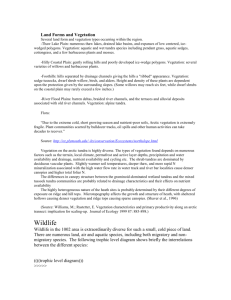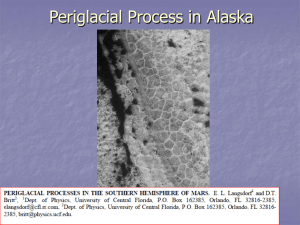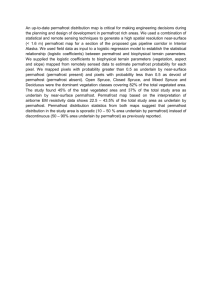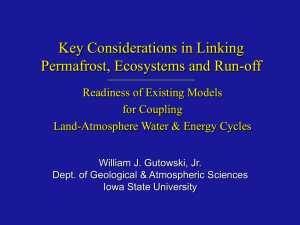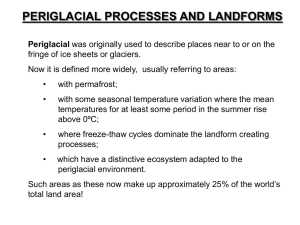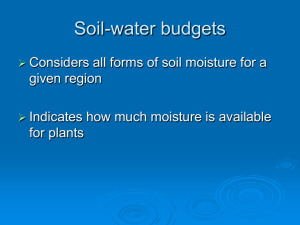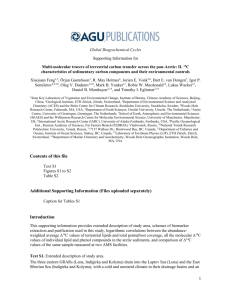cold environments
advertisement
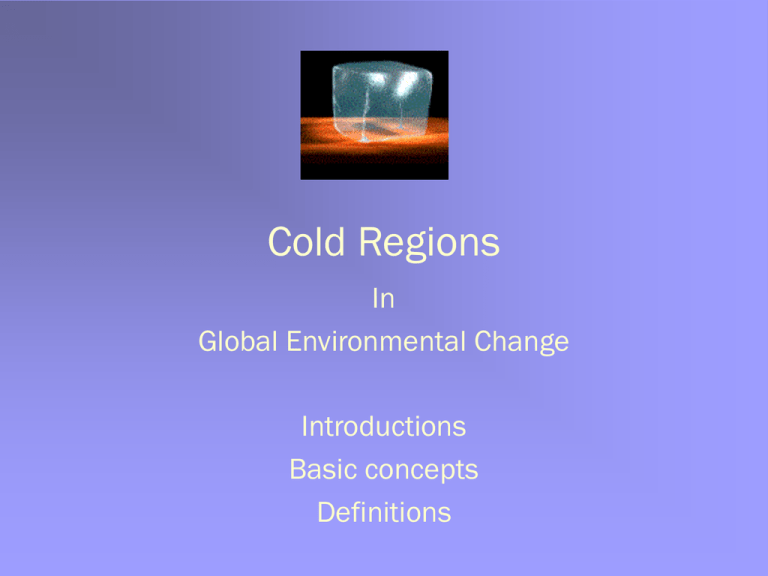
Cold Regions In Global Environmental Change Introductions Basic concepts Definitions What constitutes a region? (Revisiting Geo 105) • Formal – Some characteristic is homogeneous • Functional – Characteristic has a central node, diminishes with distance • Vernacular – Perceptual region, a region that exists as part of a people’s cultural identity Why is the concept of a region useful? • Can distinguish between areas – helps to understand process similarities and differences • Understand how differences influence interactions between regions • Understand how processes and differences affect rates of diffusion • Explain processes through understanding interactions across space What kind of regions are cold regions? • Formal – Homogeneous physical processes, strongly influenced by freezing temperatures. – Latitudes higher than 66.5°; altitudes above snow line. • Functional – Extent influenced by a particular process (e.g., influence of arctic sea ice, extent of vegetation of non-arboreal species). • Vernacular – Inuit and Saami perceptions of “home”, “hunting grounds” – Southerners perception of “The Great White North”. • Can we map cold regions? – Yes and no – Depends on definition… Where? • High Latitude – Arctic – Antarctic • High Altitude – alpine Arctic Arctic Antarctica West Antarctica East Antarctica Space shuttle view of the Andes Space shuttle view of the Himalayas Geographic Delineation • Latitude – 66 33’ N and S – http://www.athropolis.com/sun-fr.htm • Weaknesses Eagle Summit, Alaska – 66.5ºN, March Tromsø, Norway – 69.5ºN, September Other Definitions • Snowline • Vegetation – Tundra-forest ecotone, related to potential evapotranspiration (Thornthwaite, 1948) • Climate – Koppen (1936), 10°C July isotherm • Permafrost Other Definitions (2) • Snowline • Vegetation – Tundra-forest ecotone, related to potential evapotranspiration (Thornthwaite, 1948) • Climate – Koppen (1936), 10°C July isotherm • Permafrost Vegetation of CircumArctic Source: http://maps.grida.no/arctic/ Other Definitions (3) • Snowline • Vegetation – Tundra-forest ecotone, related to potential evapotranspiration (Thornthwaite, 1948) • Climate – Koppen (1936), 10°C July isotherm • Permafrost Other Definitions (4) • Snowline • Vegetation – Tundra-forest ecotone, related to potential evapotranspiration (Thornthwaite, 1948) • Climate – Koppen (1936), 10°C July isotherm • Permafrost Permafrost Distribution Why or why not study cold environments? • Sparsely populated? • US has few interests? • Doesn’t matter if climate changes there? • I’ve never visited and never plan to? Why? (from an entirely americentric viewpoint!) • Sparsely populated? – True, but how important are cold regions to the global and US economy (addresses point 2 also?) – Where does most US territory oil come from? – Where are the most strategic military sites (particularly during the cold war)? – What’s the shortest route between the U.S. and Asia and Russia? – Where does New York State buy much of its electric power from? – Where are many of the largest world coal and mineral reserves? • US has few interests? – Alaska is primarily in a cold environment. Its economy and population are part of US interest. AK is one of the country’s largest oil producing states. – Ski industry is based in cold environments. Skiing is a multimillion $ industry. – Mountain tourism, tourism in Alaska, all bring in foreign exchange. Why? • I’ve never visited and never plan to? – What’s wrong with learning about places you’ve never been? It might help alleviate all sorts of international conflict if citizens were more “global” in their knowledge. • Doesn’t matter if climate changes there? – Well, actually. . . That’s what this course is really all about. The answer to this question will be discussed throughout the semester, with the conclusion that, yes, it does matter if climate changes there.
